Russet Potatoes Substitute: 13 Healthy Potato Alternatives
Russet potatoes are one of the most popular varieties. During my health coaching sessions some clients have asked me about alternatives to them for various different reasons. Let’s take a look at substitutes which can be used in place of russet potatoes.
The following is russet potato substitutes:
- Yukon Gold potatoes
- Idaho potato
- Red potatoes
- Inca Gold Potato
- Carola Potatoes
- Yams
- Taro
- Sweet potatoes
- Turnips
- Kabocha
- Acorn squash
- Rutabaga
- Daikon radishes
This article will compare the tastes, textures and cooking methods for each one. In addition, I’ll include a side-by-side nutrient comparison of russet potatoes and the foods on the list.
In addition to coaching clients about them, I’ve purchased, researched and used the alternatives in this article prior to, during and sometimes after writing this article.
Russet Potatoes Substitute
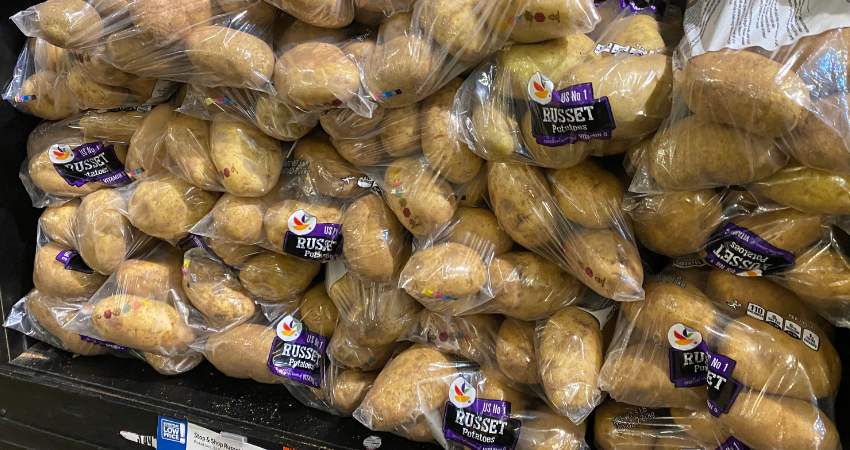
The first five are potatoes in case you’re looking for a potato substitute.
1. Yukon Gold Potatoes
Yukon Golds and russets have a mild, unsweet flavor. Yukon Gold is less starchy and more buttery. They’re both creamy making them a good substitution.
Russet is known for having a thick, tough skin. Yukon gold’s skin is thinner and another benefit if the tougher skin is undesirable.
It is also better in soups because they hold together better. Other than that it can be used for:
- Baking
- Scalloped
- French fries
- Tots
- Roasting
- Mashed potatoes
Let’s examine the nutrients between the two:
| Russet Potato, raw (100 g) | Yukon Gold Potato, raw (100 g) | |
| Calories | 79 | 74 |
| Protein | 2.14 g | 2.03 g |
| Carbohydrates | 18.1 g | 17.5 g |
| Fiber | 1.3 g | 1.4 g |
| Fat | 0.08 g | 0.05 g |
| Sugar | 0.62 g | 0.68 g |
The nutrients are almost identical except for the vitamin C. Yukon Gold contains 18.2 mg per 100 grams while russet contains 5.7 mg. I use Yukon Gold all the time. Below is a picture of some on my counter at home.
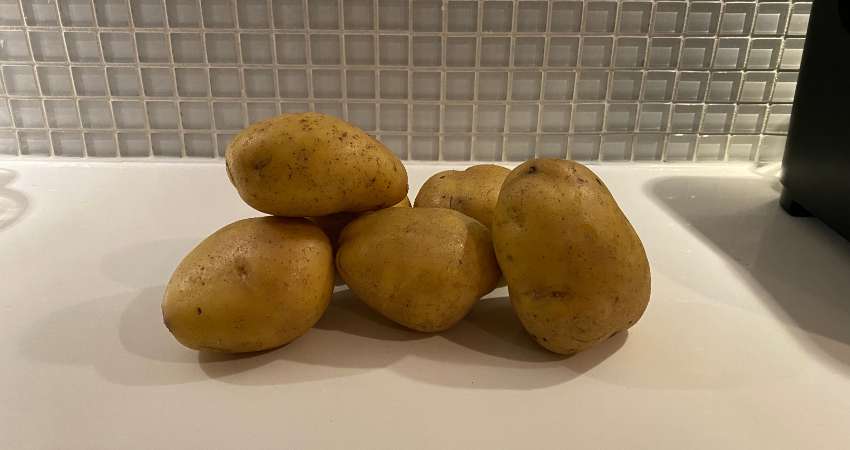
2. Idaho Potato – Particularly Russet
Idaho russet and russet are both russet potatoes. The difference is the Idaho russet refers to russet potatoes grown in Idaho.
Therefore, Idaho russet is the perfect potato for russet if you wish to keep a potato in your dish. I tried this at home and there was no difference in taste, cooking times or quantity.
Idaho’s environment is perfect for growing potatoes which is why Idaho potatoes are considered the best. The climate and soil are ideal for growing potatoes, and the russet variety is the most popular grown Idaho potato.
For these reasons I try to buy Idaho anytime I need potatoes.
A regular and an Idaho russet have a mild neutral flavor and the flesh is creamy. They both have the similar thicker and tougher skin.
They both can be used for:
- Baking
- Scalloped
- French fries
- Tots
- Roasting
- Mashed potatoes
Let’s examine the nutrients between the two:
| Russet Potato, raw (100 g) | Idaho Russet Potato, raw (100 g) | |
| Calories | 79 | 74 |
| Protein | 2.14 g | 2.03 g |
| Carbohydrates | 18.1 g | 17.6 g |
| Fiber | 1.3 g | 1.4 g |
| Fat | 0.08 g | 0.05 g |
| Sugar | 0.62 g | 0.68 g |
The nutrients are similar to each other except for the vitamin C. Idaho have more vitamin C than the regular variety.
The video below has some potato alternatives, especially for people who prefer low carb.
3. Red Potatoes
Red potatoes are smaller and rounder. They have a thinner skin, and the flesh is a creamy white. Red potatoes are less starchier but not as creamy.
Using red potatoes allows more versatility because they are better for potato salad and soups. This is so because they hold their shape better. Red potatoes can also be used for the following:
- Baking potatoes
- Roasting
- Mashed potatoes
- French frie cuts
- Tots
- Scalloping
Let’s examine the nutrients between the two:
| Russet Potato, raw (100 g) | Red Potato, raw (100 g) | |
| Calories | 79 | 70 |
| Protein | 2.14 g | 1.89 g |
| Carbohydrates | 18.1 g | 15.9 g |
| Fiber | 1.3 g | 1.7 g |
| Fat | 0.08 g | 0.14 g |
| Sugar | 0.62 g | 1.29 g |
Nutrient Resources6
The difference in nutrients with red potatoes are a little more than the other options on the list but not large enough to make a considerable difference.
Red potatoes provide a little more fiber, vitamin C, B vitamins and minerals making them a good substitution.
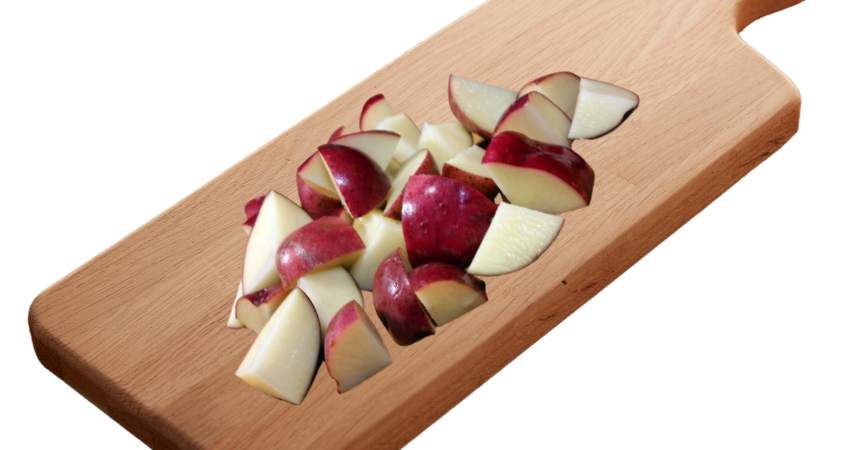
I often use red potatoes at home and roast them in a pan using avocado oil. If I have them available, I add onion and bell peppers.
4. Inca Gold Potato
Inca Gold potato is another alternative to Russets having similar characteristics but a thinner skin. Inca Gold has a yellow flesh with an earthy and buttery taste.
Although Inca Gold are smaller in size they are good to use for the following recipes:
- Roasting
- Boiling
- Potato salads
- Casseroles
- Grilling
Inca Gold are not recommended for use in soups or stews. The yellow potato nutrients are similar to Russets and the other potatoes on the list.
5. Carola Potatoes
Carola potatoes are a popular substitute for Russets because it has a firm and creamy texture.
Carola potatoes have a classic potato flavor with an earthy and buttery taste.
Although they don’t work well in soups, they can be used for the following recipes:
- Roasting
- Grilling
- Baking
- Frying
- Potato salads
- Casseroles
The nutrients between the Carola potatoes and its substitute are similar in calories, carbohydrates, fiber and protein.
6. Yams
Yams often get confused with sweet potatoes but are more like yuka. True yams have a bark-like skin with hairs. The skin is dark and the flesh is light colored.
The flesh is dry, starchy and stringy. They taste slight nutty and sweeter. Yams can be used when cooking for the following recipes:
- Mashed
- Baked
- Roasted
- Fried
True yams may be a little difficult to find in your typical supermarket. You’ll have a better chance at a local grocery store specializing in products for foreign customers. They can also be found online.
In West Africa, people often mash yams and add them to soups.
Let’s examine the nutrients between the two:
| Russet Potato, raw (100 g) | Yams, raw (100 g) | |
| Calories | 79 | 118 |
| Protein | 2.14 g | 1.53 g |
| Carbohydrates | 18.1 g | 27.9 g |
| Fiber | 1.3 g | 4.1 g |
| Fat | 0.08 g | 0.17 g |
| Sugar | 0.62 g | 0.50 g |
Nutrient Resources7
If you’re counting carbs or calories, yams aren’t the best option because they contain substantially more of each.
Yams provide less protein but more fiber.
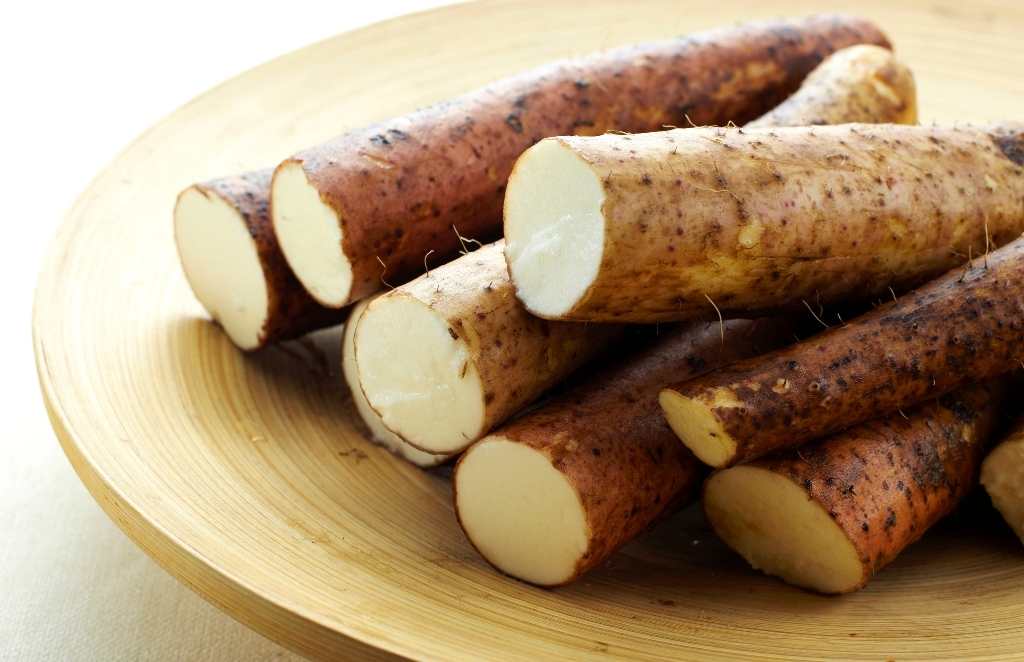
7. Taro
Taro is a starchy root vegetable with a rough, bark-like outer skin. The flesh is creamy white or purple.
Taro is slightly sweet and nuttier. It’s mashed the same as mashed potatoes. Taro has a pasty consistency. Some people call it a taro mash and in Hawaii it’s used to make poi.
Taro can also be used for the following recipes:
- Baked
- Mashed
- Fried
- Roasted
- Steamed
Let’s take a look at the nutrients.
| Russet Potato, raw (100 g) | Taro, raw (100 g) | |
| Calories | 79 | 112 |
| Protein | 2.14 g | 1.50 g |
| Carbohydrates | 18.1 g | 26.5 g |
| Fiber | 1.3 g | 4.1 g |
| Fat | 0.08 g | 0.20 g |
| Sugar | 0.62 g | 0.40 g |
Nutrient Resources8
If you’re counting calories or carbs, taro isn’t the best choice because it contains more of each. Taro provides less protein but three times more fiber. I easily find them in my local supermarket.

8. Sweet Potatoes
The texture of sweet potatoes is similar to russet potatoes. Sweet potatoes also have a rough skin although not as thick.
Sweet potatoes will increase the sweetness of the dish and is less starchy than russets. They can be cooked the same recipes including:
- Baked
- Mashed
- French fries
- Tots
- Roasting
The raw flesh of sweet potatoes is harder and will probably take a little longer to cook.
Let’s examine the nutrients between the two:
| Russet Potato, raw (100 g) | Sweet Potato, raw (100 g) | |
| Calories | 79 | 86 |
| Protein | 2.14 g | 1.57 g |
| Carbohydrates | 18.1 g | 20.1 g |
| Fiber | 1.3 g | 3.0 g |
| Fat | 0.08 g | 0.05 g |
| Sugar | 0.62 g | 4.18 g |
Nutrient Resources ((USDA: Sweet potato, raw, unprepared))
Sweet potatoes have slightly more calories and carbohydrates. The major difference between the two is how much more fiber and vitamin A sweet potatoes have.
Sweet potatoes have a little more than 14,000 IUs of vitamin A per 100 grams or about 284% of the suggested daily intake. If you use them, the number of vitamin A will be greater.
I cook sweet potatoes most of the time because they have more nutrients and vitamin A. The picture below shows my last two at home on my counter. It always seems I’m running out of them and need more.
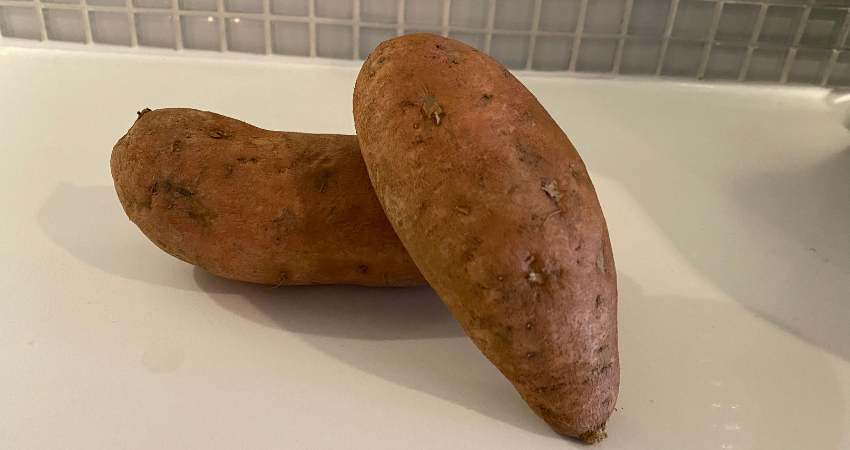
9. Turnips
Turnips are sweeter. When turnips are cooked, their consistency is similar.
You can use a turnip to do almost anything a cooked russet can do including the following types of recipes:
- Mash them
- Fry them
- Bake them
- Blend them into soups
- Tots
- Fries
Let’s examine the nutrients between the two:
| Russet Potato, raw (100 g) | Turnips, raw (100 g) | |
| Calories | 79 | 28 |
| Protein | 2.14 g | 0.90 g |
| Carbohydrates | 18.1 g | 6.4 g |
| Fiber | 1.3 g | 1.8 g |
| Fat | 0.08 g | 0.10 g |
| Sugar | 0.62 g | 3.80 g |
Nutrient Resources ((USDA: Turnips, raw))
Turnips are a great if you’re counting carbohydrates or calories. In addition, they have more calcium, fiber and vitamin C.

10. Kabocha
Kabocha taste like a mix between a sweet potato and a carrot. Therefore, it’s sweeter but not as sweet as a sweet potato.
They can be cooked the same ways including:
- Baked
- Mashed
- French fries
- Tots
- Roasting
Many people like making small chunks called bites.
Let’s examine the nutrients between the two:
| Russet Potato, raw (100 g) | Kabocha, raw (100 g) | |
| Calories | 79 | 35 |
| Protein | 2.14 g | 1.18 g |
| Carbohydrates | 18.1 g | 8.2 g |
| Fiber | 1.3 g | 1.2 g |
| Fat | 0.08 g | 0 g |
| Sugar | 0.62 g | 0 g |
Nutrient Resources9
If you’re on a Keto or low-carb diet, Kabocha is a great choice containing 10 less grams of carbohydrates per 100 grams. It also contains approximately half the calories if you’re looking to lose weight.
Some options are different for Yukon Gold potatoes. Find out how in my article, Yukon Gold Potatoes Substitute: The 13 Best Alternatives.
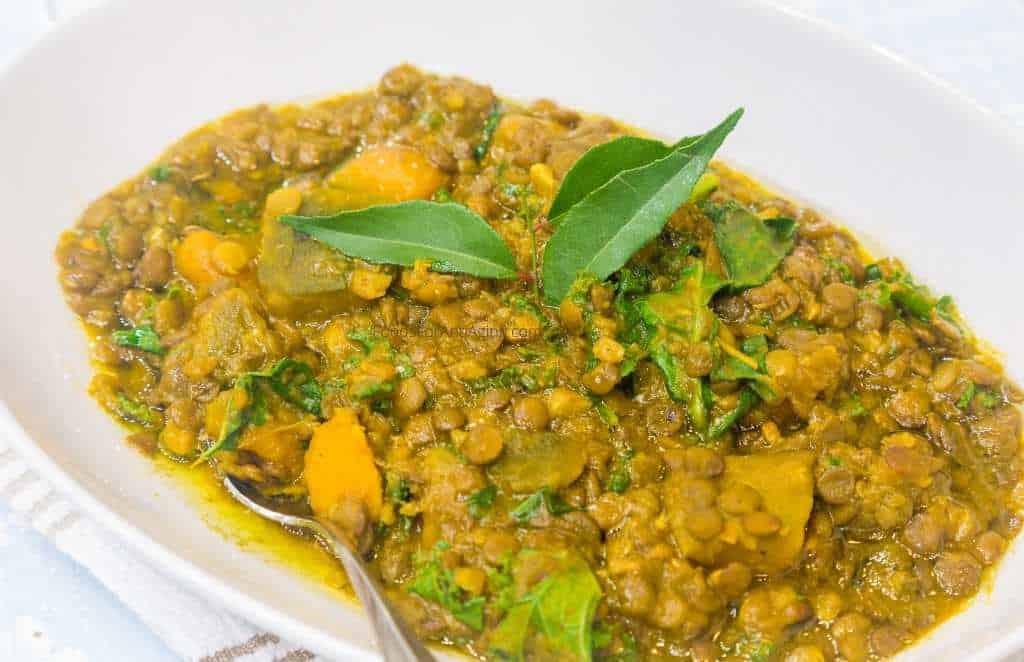
11. Acorn Squash
Acorn squash is sweeter but not as sweet as sweet potatoes. It has a nuttier taste, but the texture is more similar to potatoes.
Acorn squash can be used for the following:
- Mash
- Roast
- Bake
- Air fryer
- Fries
- Tots
Let’s examine the nutrients between the two:
| Russet Potato, raw (100 g) | Acorn Squash, raw (100 g) | |
| Calories | 79 | 40 |
| Protein | 2.14 g | 0.80 g |
| Carbohydrates | 18.1 g | 10.4 g |
| Fiber | 1.3 g | 1.5 g |
| Fat | 0.08 g | 0.10 g |
| Sugar | 0.62 g | 2.46 g |
Nutrient Resources10
Acorn squash contains fewer carbohydrates, and calories making it a good option for low-carb or Keto diets. In addition, it contains a good number of vitamin A, vitamin C and calcium.
The video below shows you how to make mashed acorn squash.
12. Rutabaga
Rutabaga is like a mix between cabbage and a turnip. They are less starchy and sweeter.
They can be used almost any way a russet potato is used including:
- Mash
- Roast
- Bake
- Soups
- Stews
Let’s examine the nutrients between the two:
| Russet Potato, raw (100 g) | Rutabaga, raw (100 g) | |
| Calories | 79 | 37 |
| Protein | 2.14 g | 1.08 g |
| Carbohydrates | 18.1 g | 8.6 g |
| Fiber | 1.3 g | 2.3 g |
| Fat | 0.08 g | 0.16 g |
| Sugar | 0.62 g | 4.46 g |
Nutrient Resources11
Rutabaga makes a good choice especially if you’re counting calories or on a low-carb diet. They also contain more calcium, folate and vitamin C.
Rutabaga is also picked in this article. Find out the other 12 in my article, Low Carb Potato Substitutes: The 13 Best Alternatives.
For most Thanksgivings, I boil and mash them in addition to potatoes and sweet potatoes.

13. Daikon
Daikon is a type of radish very common in Japanese cuisine and other East Asian cultures. It’s usually consumed raw or pickled in Japan.
Raw it tastes like a radish but it tastes surprising similarly to potatoes when baked or boiled. Other popular options are:
- “Potato” salad
- Scalloped
- Mashed
Let’s examine the nutrients between the two:
| Russet Potato, baked (100 g) | Daikon, cooked (100 g) | |
| Calories | 95 | 38 |
| Protein | 2.63 g | 0.67 g |
| Carbohydrates | 21.4 g | 3.3 g |
| Fiber | 2.3 g | 1.5 g |
| Fat | 0.13 g | 2.63 g |
| Sugar | 1.08 g | 1.80 g |
Daikon is another great low-carb choice. In addition, it contains fewer calories and more calcium, vitamin A and folate. I find them easy to find in most supermarkets as shown in my picture below during my last shopping trip.
Many options for sweet potatoes are different due to flavor. Check those out in my article, Keto Substitute for Sweet Potatoes: 8 Healthy Substitutes.
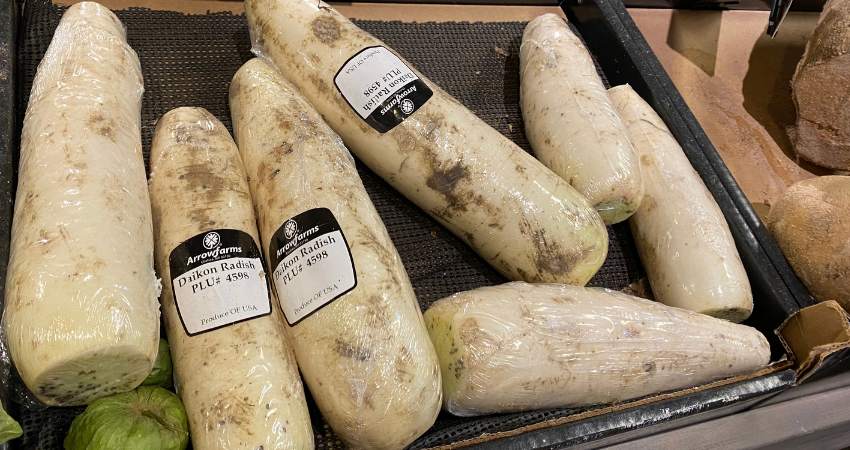
Substitute Russet Poll
To conduct some original research and get the opinions of real people, I polled my readers, clients and members of some food groups. I asked them what was the best russet potato Substitute?
- 32% said the best one was Idaho which was the winner of the poll.
If you have any questions about this article don’t hesitate to email us. You can find an email on our contact page.
Read Next – More Food Alternatives Articles!
Potato Flakes Substitutes: The 17 Best Alternatives
Mashed Potato Substitutes: 15 Healthy Alternatives
8 Healthy Sweet Potato Flour Substitutes
Alternatives To Sweet Potatoes: 16 Unbeatable Substitutes
Is It Permissible To Substitute Fruit For Vegetables?
- USDA: Potatoes, russet, flesh and skin, raw [↩]
- USDA: Yukon Gold Potatoes, Yukon Gold [↩]
- USDA: Brookshire’s, Yukon Gold Potatoes [↩]
- USDA: Idaho Russet Potatoes [↩]
- The Idaho Potato Commission: Idaho Potato Nutrition Facts [↩]
- USDA: Potatoes, red, flesh and skin, raw [↩]
- USDA: Yam, raw [↩]
- USDA: Taro, raw [↩]
- USDA: Kabocha Squash [↩]
- USDA: Squash, winter, acorn, raw [↩]
- USDA: Rutabagas, raw [↩]
- USDA: Daikon radish, cooked [↩]
- USDA: Potatoes, Russet, flesh and skin, baked [↩]
